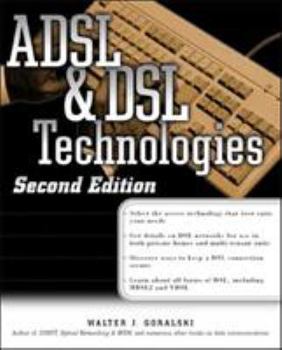ADSL and DSL Technologies
Select Format
Select Condition 
Book Overview
This comprehensive guide shows telecommunication engineers and DSL vendors how to quickly get a handle on ADSL and DSL technology without having to wade through technical documentation. In addition,... This description may be from another edition of this product.
Format:Paperback
Language:English
ISBN:0072132043
ISBN13:9780072132045
Release Date:October 2001
Publisher:McGraw-Hill Companies
Length:512 Pages
Weight:2.05 lbs.
Dimensions:1.2" x 7.5" x 9.1"
Customer Reviews
5 ratings
Well written primer
Published by Thriftbooks.com User , 25 years ago
The book is well written (by computer book standards :) ), and offers a surprising amount of information about the current US phone system (europeans, africans, etc. are out of luck....). It would have been interesting if there had been information about say Covad, Cisco and others who are actually implementing these technologies.
the best on ADSL
Published by Thriftbooks.com User , 26 years ago
As a sales person of department ADSL, I reference new sales people within our company who want to know more on ADSL to read this book first. It starts at the basics, then explains the migration paths, DSL forms, and ends with open issues. It doesn't state, but explains, and gives both the advantages and downsides.I've read what there was to read on DSL: magazines, whitepapers, books. In the end, I kept coming back to this great book.
A comprehensive overview of xDSL
Published by Thriftbooks.com User , 26 years ago
Writing a popular book about xDSL technology is a daunting task, but one that Walter Goralski largely accomplishes in his book "ADSL and DSL technologies." The book begins with a global view of the US telecommunications network, how the Internet is challenging this network, and what technologies are being developed to address the problems. This world view does an excellent job of placing xDSL technologies in perspective: they are solutions to digital data transport over portions of a telecommunications network designed specifically for analog voice traffic. The author has provide an excellent summary of how the American telephone network began, how it evolved, the various regulatory actions along the way, and the current state of affairs. For example, many people familiar with load coils and bridge taps know they can cause problems for xDSL technologies. Goralski explains how these devices got into the network in the first place, and the specific problems they pose for digital high-speed technologies. As part of this discussion the author describes the first analog systems, later digital systems, multiplexing and trunk topologies, different switching technologies (packet and circuit) and the first wave of digital services such as ISDN.After a brief discussion of modems, the author launches into the main subject, which is the xDSL family of products and technology. He gives a brief high-level descriptions of HDSL, SDSL, RADSL, CDSL, IDSL, ADSL, and VDSL. Up to this point the number of acronyms is relatively manageable, but once he begins discussing xDSL in earnest the acronyms emerge exponentially. Fortunately, Goralski has a list of about 250 acronyms in the back of the book. This list is especially useful later in the book where the author uses them with abandon. Though extensive, the list is not complete. For example, the acronyms PCM and STU are not included. Of course, the author says there is "really no such thing as an `STU,' at least not as a standard device." This only adds to the confusion of the use of such an acronym, and contributes to the "acronym overload" one often feels when reading this book.After the brief introduction to the xDSL family, the author devotes a full chapter each to HDSL and then to ADSL. After this, the book deals almost exclusively with ADSL-related issues (except for a chapter on VDSL at the back of the book). I was disappointed the author spent so little time describing the digital coding techniques that are so important for DSL technologies. Except for a brief mention of QAM, the author leaves his audience almost entirely in the dark as to how the digital codes work, and what are their individual strengths and weaknesses. The author goes into considerable detail (more than any other individual topic) describing the ADSL architecture and interface systems. Chapter nine, dealing with ADSL interfaces, is confusing and would benefit from more diagrams. S
A Uniquely Informative Analysis of Digital Communications
Published by Thriftbooks.com User , 26 years ago
This is a very helpful account of both a new technology and the factors that motivated its development. The first half of Goralski's analysis provides an in depth historical perspective of standard telephonic communication. Initially I was impatient with that treatment, but I came to appreciate the significance of how the old informs the new. In the second half of the book, each permutation of the DSL architecture is treated individually in some depth. Anyone who has a need to come to terms with this sometimes confusing arena will benefit directly from Goralski's efforts.
Well written, complete and accessible DSL information
Published by Thriftbooks.com User , 26 years ago
This book is exceptionally well-written. xDSL is being touted as 'the next big thing' in telco/internetworking and Mr Goralski does an oustanding job of presenting historical, technical and conceptual information that is complete yet accessible to the non-engineer.I do technical sales - which is to say being able to translate the telco-arcane to the 'real world' customer and being able to communicate customer needs to central office engineering and product development. Mr Goralski provides a great example of how this can be done well.





